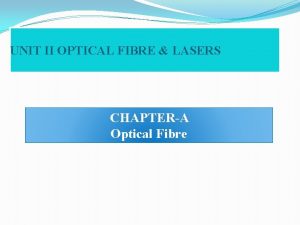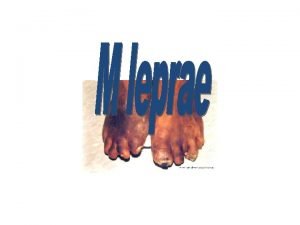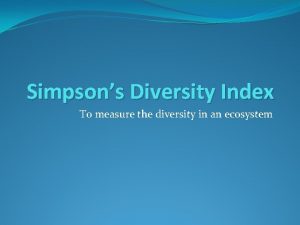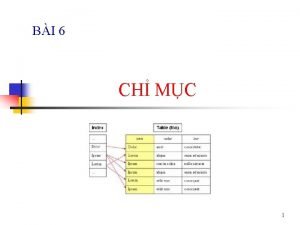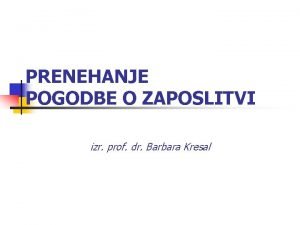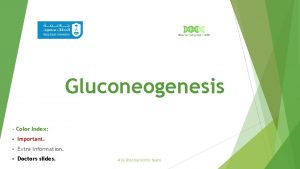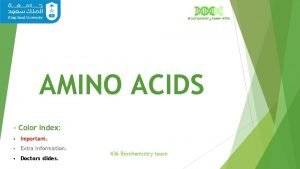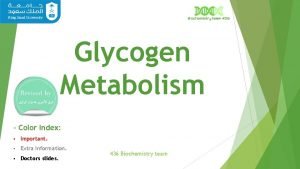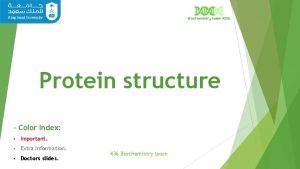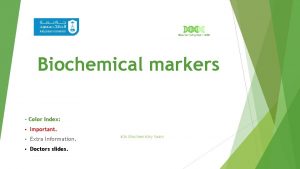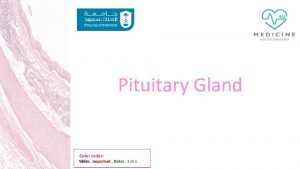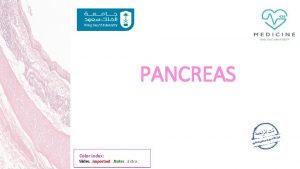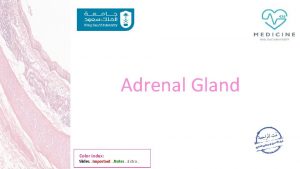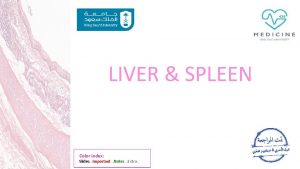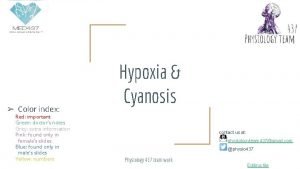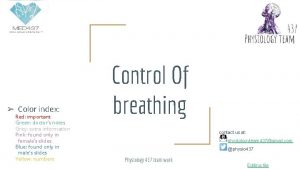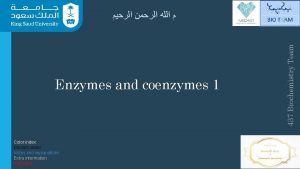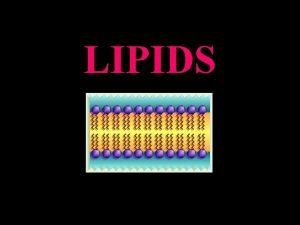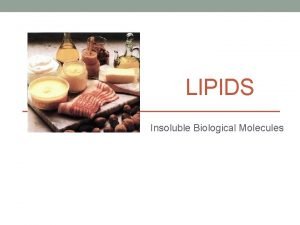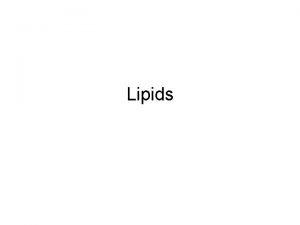LIPIDS Color Index Important Extra Information Doctors slides



















- Slides: 19

LIPIDS – Color Index: § Important. § Extra Information. § Doctors slides. 436 Biochemistry team

Objectives Define and classify lipids Understand the physiological importance of lipids List the examples of simple and complex lipids 436 Biochemistry team Correlate implications of lipids in clinical conditions

Heterogeneous group of hydrophobic (water–insoluble) organic molecules that are soluble in organic solvents. What are the lipids ? Body lipids are compartmentalized (packed) in cell membranes, tissue and plasma. Lipids Essential components of cell membranes Lipids+hydrocarbon chains = energy stores The functions of lipids Cell signaling involves lipid molecules e. g : inositol triphosphate ﺍﻟﻠﺒﻴﺪ ﺗﻌﻄﻴﻨﺎ ﻃﺎﻗﺔ ﺿﻌﻒ ﺍﻟﻜﺮﺑﻮﻫﻴﺪﺭﺍﺕ Fat-soluble vitamins , steroid hormones and prostaglandins are formed of lipids Metabolic syndrome Obesity Hypertension Lipids and disease Disease that are strongly associated with abnormal in lipids metabolism: Coronary artery disease Heart disease Atherosclerosis

Classification of lipids Complex lipids Simple lipids Fatty acids Triacylglycero l Steroids (cholesterol) Phospholipids The lipids compound is heterogeneous group Glycolipids are lipids with a carbohydrate attached by a glycosidic bond. Sphingolipids Glycolipids

Fatty Acids (FAs) FAs are carboxylic acid and long-chain of hydrocarbon. Amphipathic (hydrophobic tails and hydrophilic head). The hydrocarbon chain is hydrophobic. The carboxylic group(COOH) is hydrophilic. Insoluble in water. FAs must be transported in plasma via proteins (Albumin is an example of fatty acid transporter). The majority of plasma FAs are esters of (Triacylglycerol, Cholesterol, and Phospholipids). The FAs chain length in mammals it differs from C 16 -C 18 For example: palmitic, oleic and stearic acids 436 Biochemistry team


Essential Fatty Acids There are two essential fatty acids that our bodies can not synthesize so they must be supplied in diets which are Linoleic acid and Alpha-Linolenic acid Deficiency can cause dermatitis, membrane function loss. Linoleic acid (precursor of arachidonic acid). That means that Arachidonic acid is non essential so our bodies can produce it when Linoleic acid is present. But actually Arachidonic acid is considered as conditional fatty acid because … Arachidonic acid is essential where Linoleic acid is deficient in the diet 436 Biochemistry team

W-3 and W-6 Fatty Acids (w = omega) W-3 Long chain polyunsaturated FA’s with first double bond starting with third carbon from the methyl end They reduce serum triglycerides, blood pressure and risk for heart disease W-6 Long chain polyunsaturated with first double bond starting with the sixth carbon from the methyl end They reduce serum cholesterol Major source: vegetable oil – nuts Major source: fish Examples: v Alpha-linolenic acid v EPA (eicosapentaenoic acid) v DHA (Docosahexaenoic acid) Example: v Linoleic acid 18: 2 436 Biochemistry team Double “ ﻧﺒﺪﺃ ﺍﻟﺒﺤﺚ ﻋﻦ ﺫﺭﺓ ﺍﻟﻜﺮﺑﻮﻥ ﺍﻟﺘﻲ ﺗﺤﻤﻞ . (C=O) ” ﻣﻦ ﺍﻟﺠﻬﺔ ﺍﻟﺒﻌﻴﺪﺓ ﻋﻦ bond Omega-3 <---- ﺍﺫﺍ ﻛﺎﻧﺖ ﺍﻟﺬﺭﺓ ﺍﻟﺜﺎﻟﺜﺔ Omega-6 <---- ﺍﺫﺍ ﻛﺎﻧﺖ ﺍﻟﺬﺭﺓ ﺍﻟﺴﺎﺩﺳﺔ

Triacylglycerols (TGs) -Three fatty acids with a glycerol bonded are called triglyceride* (TGs) also known as fat. -A triglyceride (TGs) Are tri-ester** of fatty acid With a glycerol molecule bounded to them. -Constitutes majority of dietary: ﻳﻌﻨﻲ ﻣﻌﻈﻢ ﺍﻟﺪﻫﻮﻥ ﻓﻲ ﻏﺬﺍﺋﻨﺎ ﻣﻦ ﻫﺬﺍ ﺍﻟﻨﻮﻉ -stored in adipocyte (fat cells) as energy reservoir*** -not a component of cell membrane: ﻟﻴﺲ ﻣﻦ ﺍﺣﺪ ﻣﻜﻮﻧﺎﺕ ﺍﻟﻐﺸﺎﺀ ﺍﻟﺨﻠﻮﻱ -subcutaneous layer of fats provides thermal insulation**** *also called triacylglycerol **tri-ester means 3 ester, ester is a fatty acid with alcohol ( in this case the alcohol is glycerol ) ***reservoir: ﻣﺨﺰﻥ **** ﺗﺸﻜﻞ ﻃﺒﻘﺔ ﺗﺤﺖ ﺍﻟﺠﻠﺪ ﺗﻌﻤﻞ ﻛﻌﺎﺯﻝ ﺣﺮﺍﺭﻱ ﺗﺤﻤﻲ ﺍﻟﺠﺴﻢ ﻣﻦ ﺍﻟﺒﺮﻭﺩﺓ

Steroids with a hydroxyl group (OH) are called sterols Consists of four fused rings called steroid nucleus with 8 -carbon chain are a derivatives of Cyclopentanoperhydrophenenthrene ring Or simply called steroid nucleus - Cholesterol is a major sterol in humans and animal - Cholesterol in plasma is bound to fatty acids called cholesteryl esters - Cholesterol in cell membrane and bile is free (not bound to fatty acid) Functions of cholesterol - Component of cell membranes • • • Precursor for: Bile acids / Bile salts Vitamin D Steroid hormones (Aldosterone, cortisol, testosterone, estrogen, progesterone) - High levels of plasma cholesterol is strongly associated with coronary artery disease and atherosclerosis

Ø Major components of biological membranes. Ø Examples: Phosphatidic acid , phosphatidyl – choline and serine. Phospholipids Tow classes: Glycerophospholipids (Contain glycerol backbone) Ø Glycerol-3 -PO 4 is bonded to two fatty acid chains. Ø The PO 4 group is linked to a hydrophilic group. Ø Amphiphilic in nature: • Hydrophobic tail. • Hydrophilic phosphoryl heads. Sphingophospholipids (Contain Sphingosine) Long-chain fatty acids attached to sphingosine. Example: Sphingomyelin. *An important component of myelin that protects and insulates nerve fibers *axons*. * Sphingomyelin is the only type of Sphingophospholipids in human. Ø

Glycerophospholipids *You don’t have to memorize the structure Serine Ethanolamin Choline Sphingophospholipids

Glycolipids (glycosphingolipids) Contain both carbohydrate and lipid components. glycolipids are derivatives of ceramides ( A long-chain fatty acid is attached to the amino alcohol sphingosine. Also called glycoshpingolipids ). Examples: Ganglioside, glactocerebroside. Act as : blood group antigens , cell surface receptors for bacteria and viruses. glycosphingolipids are essential components of all membranes in the body, but they are found in great amounts in nerve tissue

*Additional slide Glycolipids Two type Acidic glycosphingolipids Neutral glycosphingolipids (negatively charged) (uncharged) example Sulfatides function found predominantly in the brain and kidneys example Gangliosides function are found primarily in the ganglion cells of the CNS Galactocerebroside function synthesis and degradation of the more complex glycosphingolipid

Transport of plasma lipids definition Protein part • Plasma lipids are transported as lipoprotein particles (lipids + protein ) • Apoprotein or Apolipoprotein examples • apolipoprotein A, B, C Function • Lipid transport, enzymatic function, ligands for receptor lipid part • Contains lipids of various types Apolipoprotein • The apolipoproteins associated with lipoprotein particles have a number of diverse functions, such as providing recognition sites for cell-surface receptors and serving as activators or coenzymes for enzymes involved in lipoprotein metabolism. Lipoproteins are composed of a neutral lipid core (containing triacylglycerol [TAG] and cholesteryl esters) surrounded by a shell of amphipathic apolipoproteins

Types and function of lipoprotein Lipoprotein Chylomicrons Very low density lipoprotein (VLDL) Low density lipoprotein (LDL) High density lipoprotein (HDL) Transports *You have to know the majority of every Lipoprotein Majority Dietary TGs Triacylglycerol Endogenous TGs Triacylglycerol Free cholesterol Cholesteryl esters Protein The more Triacylglycerol are the size is bigger and the density is low. Density is how viscous or how fatty the substance is. HDL they are the heaviest and the highest density and the smallest in size. Chylomicron they are the biggest in size and the lowest density.

*Additional slide Types and function of lipoprotein

MCQs + vedios 4 -d 3 -a 1 - What statement from the following is false. 2 -b a. Atherosclerosis can be caused by lipids 1 -b b. The carboxylic group in fatty acids is hydrophobic c. Lipids store energy d. Fatty acids are amphipathic 2 - the fatty acid chain length in mammals varies between. a. c 12 -c 19 b. c 16 -c 18 c. c 17 -c 19 d. c 14 -c 16 3 - what is the major source of w-3. a. Fish b. Chicken c. Nuts d. Dairy products 4 - What statement is false about lipoprotein’s functions. a. Ligands for receptors b. lipid transport c. enzymatic functions • https: //youtu. be/H 8 WJ 2 KENl. K 0? t=6 m 56 s • https: //www. youtube. com/watch? v=O 9 l. L 2 KSt. W 9 s d. lipid protection

 A small child slides down the four frictionless slides
A small child slides down the four frictionless slides Each of the boxes shown is pulled for 10 m
Each of the boxes shown is pulled for 10 m Formal and informal relative clauses
Formal and informal relative clauses Extra information clauses
Extra information clauses Relative clause with extra information
Relative clause with extra information Example of a news story
Example of a news story From most important to least important in writing
From most important to least important in writing Least important to most important
Least important to most important Diff between step index and graded index fiber
Diff between step index and graded index fiber Primary index is dense or sparse
Primary index is dense or sparse Morphological index and bacteriological index
Morphological index and bacteriological index Physical quality of life index and human development index
Physical quality of life index and human development index Optical fiber waveguide
Optical fiber waveguide Simpsons diversity index equation
Simpsons diversity index equation Consistency index
Consistency index Clustered index và non clustered index
Clustered index và non clustered index Kentish town doctors
Kentish town doctors Trinity doctors
Trinity doctors Go 354 tamil nadu
Go 354 tamil nadu Odpoved pogodbe best doctors
Odpoved pogodbe best doctors








